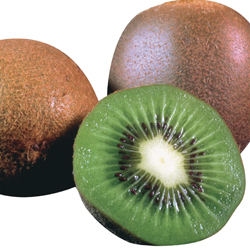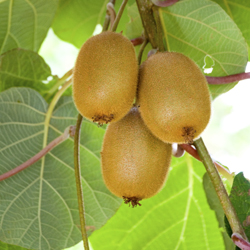Although native to southern China, New Zealand growers export the fruit to the US. Today, California produces 98% of the country’s kiwifruit supply. In addition, they grow very well in our area. You can harvest your fruit in the fall and store it to ensure you have a natural supply of vitamin C all through the winter as Kiwifruit has twice as much as an orange.
Now you know you want to grow your own kiwifruit, there are two ways to do it. The first is to plant it next to a support and let it grow. This results in a sprawling and robust vine haphazardly producing fruit while requiring annual whacking to keep it in bounds.
However, a well-tended, pruned and trained Kiwifruit can produce 200 pounds of fruit per year. Yes, it takes some effort and a plan, but a productive kiwifruit is also a beautiful addition to the garden. Here’s how to do it:
Step one: You will need two plants, a male and female, to grow your own kiwifruit. Although there are several self-fertile varieties such as ‘Blake,’ most kiwifruit varieties are “dioecious” meaning there are male and female plants. The female plant produces flowers that become fruits if a male plant of a different variety is nearby to cross-pollinate the flowers. The most commonly grown female variety is ‘Hayward.’ The commonly grown male varieties are Chico, Matua and Tamori. One male plant is sufficient for eight females.
Second, Kiwifruit grows best on a warm site with wind protection. The soil should be well drained and generally moist. Provide frost protection if temperatures dip below freezing. The fuzzy varieties require more protection than the smooth fruits.
Third, as mentioned, Kiwifruit grows on a vine, dormant from December through March. It leafs out in March, blooms in May and the fruit is harvested in October and November. Here are the basics for training:
- Construct the frame. This can be a trellis, or horizontal wires between 6′ tall supports or a pergola canopy. The more simple the shape, the easier it will be to train and maintain the vine.
- Grow a strong vertical trunk by training the most robust shoot along the vertical axis of the frame. Tie every 6″. (If the plant has a graft, be sure the chosen shoot is above the graft.)
- Begin training “cordons,” or side-shoots, as the trunk reaches the first intersection of the frame. In other words, when the trunk reaches the first horizontal wire or timber of the trellis or framework, prune the trunk to just below the height of the intersection. Soon two shoots will grow from the top bud. Train these shoots along the horizontal axis, tying every 6″. Repeat this process each year as the trunk reaches the next intersection.
- In the next dormant season, remove all trunk growth (extra shoots from the trunk) and prune the cordons to 2′ long. In the following dormant seasons, again remove all but 2′ of new growth. This will create 6′ long cordons in three years. For the highest productivity, do not grow the cordons longer than 7′-8′.
- “Fruiting arms” grow from the cordons and drape over the wire or wood supports. Prune to space the arms one foot apart in opposite directions. Tie the arms to side wires or framework to protect from wind damage. The first crop will grow from these arms. The following fruits will be on lateral shoots coming from the arms.
After basic training, a simple pruning schedule will maintain the productivity and beauty of the vine:
- Winter: Cut laterals back to within a few new buds from prior year fruiting arms, to approximately 18″ long. Remove any crossing or weak shoots. Remove fruiting arms older than three years and allow new ones to form.
- Summer: Prune to maintain form and shape. Remove all growth on the trunk. Reduce any shoots on the cordons to short stubs, leaving buds for future fruiting arms. Remove any tangled shoots to prevent strangling.
As they don’t produce fruit, severely prune the male plants by removing up to 70% of the prior year’s growth. Cut the flowering shoots back to the new shoots.
No matter how you’ve grown your kiwifruit, harvest the fruit by breaking it from the stalks when the skin is brown or when cutting through a fruit sample shows black seeds. When first harvested, the fruit will be hard, but after setting out at room temperature for a week, it will soften and sweeten. You may store the fruit for two months in a cool room or in a refrigerator for up to nine months. Just retrieve and let soften before eating. Putting it in a plastic bag with a cut apple or banana will speed ripening.








